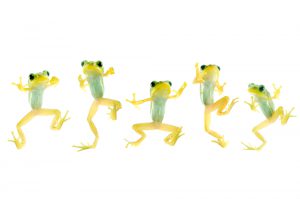Frog Choruses Sing Out a Song of Creation
My last name, Rana, is Sanskrit in origin, referring to someone who descends from the Thar Ghar aristocracy. Living in Southern California means I don’t often meet Urdu-speaking people who would appreciate the regal heritage connected to my family name. But I do meet a lot of Spanish speakers. And when I introduce myself, I often see raised eyebrows and smiles.
In Spanish, Rana means frog.
My family has learned to embrace our family’s namesake. In fact, when our kids were little, my wife affectionately referred to our five children as ranitas—little frogs.

Image: Five Ranitas. Image credit: Shutterstock
Our feelings about these cute and colorful amphibians aside, frogs are remarkable creatures. They engage in some fascinating behaviors. Take courtship, as an example. In many frog species, the males croak to attract the attention of females, with each frog species displaying its own distinct call.
Male frogs croak by filling their vocal sacs with air. This allows them to amplify their croaks for up to a mile away. Oftentimes, male frogs in the same vicinity will all croak together, forming a chorus.

Image: Male Frog Croaking to Attract a Female. Image credit: Shutterstock
As it turns out, female frogs aren’t the only ones who respond to frog croaks.
A research team from Japan has spent a lot of time listening to and analyzing frog choruses with the hopes of understanding the mathematical structure of the sounds that frogs collectively make when they call out to females. Once they had the mathematical model in hand, the researchers discovered that they could use it to improve the efficiency of wireless data transfer systems.1
This work serves as one more example of scientists and engineers applying insights from biology to drive technology advances and breakthroughs. This approach to technology development (called biomimetics and bioinspiration)—exemplified by the impressive work of the Japanese researchers—has significance that extends beyond engineering. It can be used to make the case that a Creator must have played a role in the design and history of life by marshaling support for two distinct arguments for God’s existence:
- The argument from beauty
- A new variation on the Watchmaker argument, dubbed the converse Watchmaker argument
Frog Choruses: A Cacophony or a Symphony?
Anyone who has spent time near a pond at night certainly knows the ruckus that an army of male frogs can make when each of them is vying for the attention of females.
All the male frogs living near the pond want to attract females to the same breeding site, but, in doing so, each individual also wants to attract females to his specific territory. Field observations indicate that, instead of engaging in a croaking free-for-all (with neighboring frogs trying to outperform one another), the army of frogs engages in a carefully orchestrated acoustical presentation. As a result, male frogs avoid call overlap with neighboring males on a short timescale, while synchronizing their croaks with the other frogs to produce a chorus on a longer timescale.
The frogs avoid call overlap by alternating between silence and croaking, coordinating with neighboring frogs so that when one frog rests, another croaks. This alternating back-and-forth makes it possible for each individual frog to be heard amid the chorus, and it also results in a symphonic chorus of frog croaks.
The Mathematical Structure of Frog Choruses
To dissect the mathematical structure of frog choruses, the research team placed three male Japanese tree frogs into individual mesh cages that were set along a straight line, with a two-foot separation between each cage. The researchers recorded the frog’s croaks using microphones placed by each cage.
They observed that all three frogs alternated their calls, forming a triphasic synchronization. One frog croaked continuously for a brief period of time and then would rest, while the other two frogs took their turn croaking and resting. The researchers determined that the rest breaks for the frogs were important because of the amount of energy it takes the frogs to produce a call.
All three frogs would synchronize the start and stop of their calls to produce a chorus followed by a period of silence. They discovered that the time between choruses varied quite a bit, without rhyme or reason, and was typically much longer than the chorus time. On the other hand, the croaking of each individual lasted for a predictable time duration that was followed immediately by the croaking of a neighboring frog.
By analyzing the acoustical data, the researchers developed a mathematical model to describe the croaking of individual frogs and the collective behavior of the frogs when they belted out a chorus of calls. Their model consisted of both deterministic and stochastic components.
Use of Frog Choruses for Managing Data Traffic
The researchers realized that the mathematical model they developed could be applied to control wireless sensor networks, such as those that make up the internet of things. These networks entail an array of sensor nodes that transmit data packets, delivering them to a gateway node by multi-hop communication, with data packets transmitted from sensor to sensor until it reaches the gate. During transmission, it is critical for the system to avoid the collision of data packets. It is also critical to regulate the overall energy consumption of the system, to avoid wasting valuable energy resources.

Image: The Internet of Things Made Up of Wireless Sensors. Image credit: Shutterstock
Through simulation studies, the Japanese team demonstrated that the mathematical model inspired by frog choruses averted the collision of data packets in a wireless sensor array, maximized network connectivity, and enhanced efficiency of the array by minimizing power consumption. The researchers conclude, “This study highlights the unique dynamics of frog choruses over multiple time scales and also provides a novel bio-inspired technology.”2
As important as this work may be for inspiring new technologies, as a Christian, I find its real significance in the theological arena.
Frog Choruses and the Argument from Beauty
The grandeur of nature touches the very core of who we are—if we take the time to let it. But, as the work by the Japanese researchers demonstrates, the grandeur we see all around us in nature isn’t confined to what we perceive with our immediate senses. It exists in the underlying mathematical structure of nature. It is nothing short of amazing to think that such exquisite organization and orchestration characterizes frog choruses, so much so that it can inspire sophisticated data management techniques.
From my vantage point, the beauty and mathematical elegance of nature points to the reality of a Creator.
If God created the universe, then it is reasonable to expect it to be a beautiful universe, one that displays an even deeper underlying beauty in the mathematical structure that defines the universe itself and phenomena within the universe. Yet if the universe came into existence through mechanism alone, there isn’t any real reason to think it would display beauty. In other words, the beauty in the world around us signifies the divine.
Furthermore, if the universe originated through uncaused physical mechanisms, there is no reason to think that humans would possess an appreciation for beauty.
A quick survey of the scientific and popular literature highlights the challenge that the origin of our aesthetic sense creates for the evolutionary paradigm.3 Plainly put: evolutionary biologists have no real explanation for the origin of our aesthetic sense. To be clear, evolutionary biologists have posited explanations to account for the genesis of our capacity to appreciate beauty. But after examining these ideas, we walk away with the strong sense that they are not much more than “just-so stories,” lacking any real evidential support.
On the other hand, if human beings are made in God’s image, as Scripture teaches, we should be able to discern and appreciate the universe’s beauty, made by our Creator to reveal his glory and majesty.
Frog Choruses and the Converse Watchmaker Argument
The idea that biological designs—such as the courting behavior of male frogs—can inspire engineering and technology advances is also highly provocative for other reasons. First, it highlights just how remarkable and elegant the designs found throughout the living realm actually are.
I think that the elegance of these designs points to a Creator’s handiwork. It also makes possible a new argument for God’s existence—one I have named the converse Watchmaker argument. (For a detailed discussion, see my essay titled “The Inspirational Design of DNA” in the book Building Bridges.)
The argument can be stated like this:
- If biological designs are the work of a Creator, then these systems should be so well-designed that they can serve as engineering models for inspiring the development of new technologies.
- Indeed, this scenario plays out in the engineering discipline of biomimetics.
- Therefore, it becomes reasonable to think that biological designs are the work of a Creator.
In fact, I will go one step further. Biomimetics and bioinspiration logically arise out of a creation model approach to biology. That designs in nature can be used to inspire engineering makes sense only if these designs arose from an intelligent Mind.
In fact, I will go one step further. Biomimetics and bioinspiration logically arise out of a creation model approach to biology. That designs in nature can be used to inspire engineering makes sense only if these designs arose from an intelligent Mind. The mathematical structure of frog choruses is yet another example of such bioinspiration.
Frogs really are amazing—and regal—creatures. Listening to a frog chorus can connect us to the beauty of the world around us. And it will one day help all of our electronic devices to connect together. And that’s certainly something to sing about.
Resources
- God and the World of Insects (see chapter 8), edited by Josh Shoemaker and Gary Braness (book)
- Building Bridges: Presentations on RTB’s Testable Creation Model by Fazale Rana, Anjeanette Roberts, and Jeff Zweerink (book)
- “Get Smart about Synthetic Spider Silks” by Katie Galloway (article)
- “The Road Less Traveled Is Not for Ants” by Katie Galloway (article)
- “Spider Silk Inspires New Technology and the Case for a Creator” by Fazale Rana (article)
- “Beetles Inspire an Engineering Breakthrough” by Fazale Rana (article)
- “Fireflies Inspire Better LEDs” by Jeff Zweerink (article)
- “Earwax Discovery Gives New Hearing to the Case for Intelligent Design” by Fazale Rana (article)
- “Hagfish Slime Expands the Case for a Creator” by Fazale Rana (article)
- “Engineers’ Muse: The Design of Biochemical Systems” by Fazale Rana (article)
- “Fatty Acids Are Beautiful” by Fazale Rana (article)
- “Whale Vocal Displays Make Beautiful Case for a Creator” by Fazale Rana (article)
Check out more from Reasons to Believe @Reasons.org
Endnotes
- Ikkyu Aihara et al., “Mathematical Modelling and Application of Frog Choruses As an Autonomous Distributed Communication System,” Royal Society Open Science 6, no. 1 (January 2, 2019): 181117, doi:10.1098/rsos.181117.
- Aihara et al., “Mathematical Modelling and Application.”
- For example, see Ferris Jabr, “How Beauty is Making Scientists Rethink Evolution,” The New York Times Magazine, January 9, 2019, https://www.nytimes.com/2019/01/09/magazine/beauty-evolution-animal.html.





